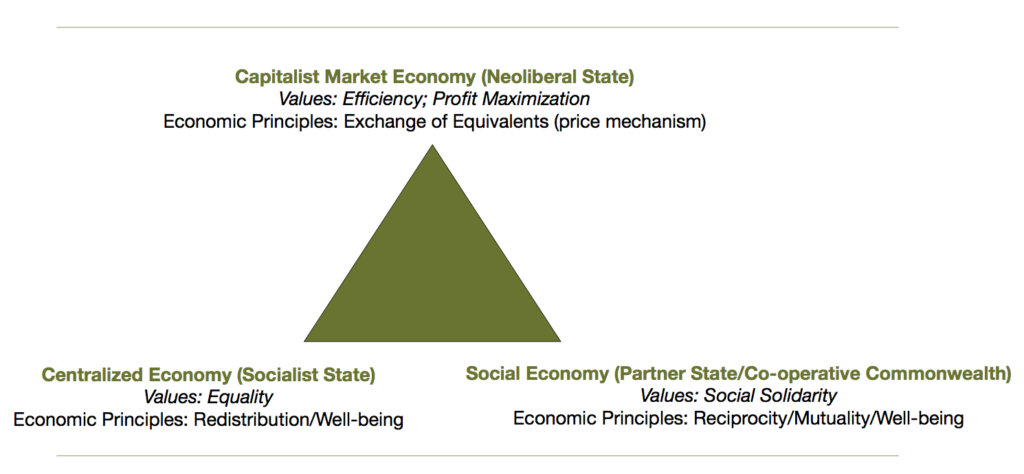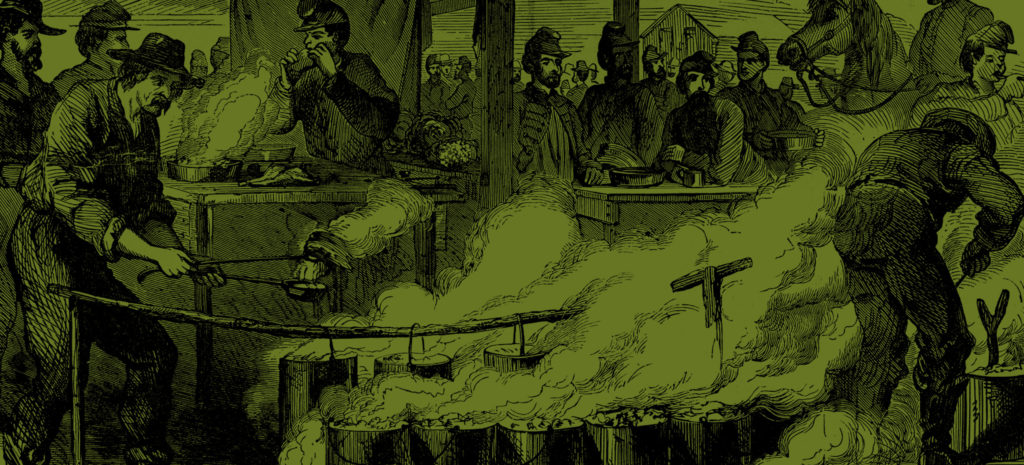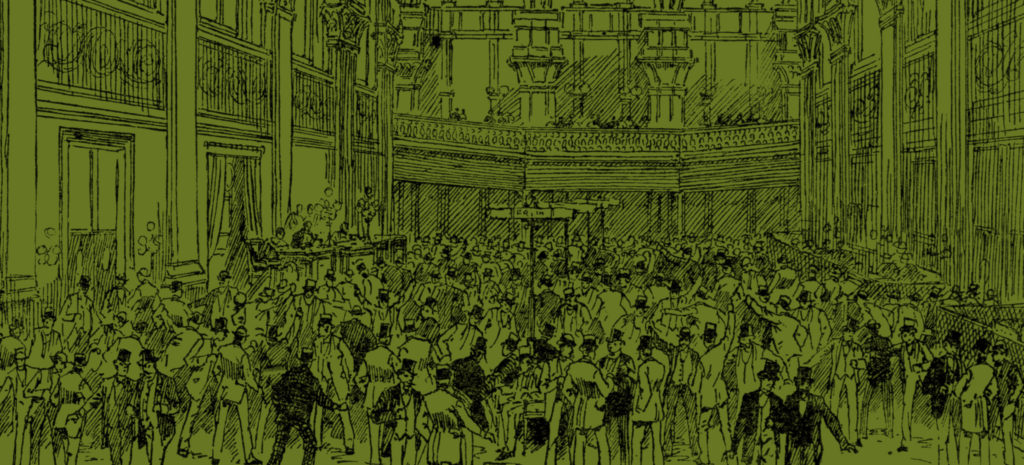Cooperative Commonwealth & the Partner State
PARADIGM CHANGES, 24 Apr 2017
John Restakis | The Next System Project – TRANSCEND Media Service
18 Apr 2017 – This paper is one of many proposals for a systemic alternative we have published or will be publishing here at the Next System Project. We have commissioned these papers in order to facilitate an informed and comprehensive discussion of “new systems,” and as part of this effort, we have also created a comparative framework which provides a basis for evaluating system proposals according to a common set of criteria.
Overview
“The country of one’s dreams must be a country one can imagine being constructed, over the course of time, by human hands.”
-Richard Rorty
Among capitalism’s many critics, it is standard procedure to state that neoliberalism has failed and that unless our societies construct a new paradigm for how economies work, human societies will collapse under the weight of an unsustainable and environmentally catastrophic capitalist system.
The International Monetary Fund (IMF), the most powerful purveyor of neoliberal ideas over the last forty years, has now admitted that perhaps its signature ideology has been oversold, and that the costs of free market ideology may have outweighed the touted benefits. When this happens, we may be sure something has reached a breaking point. Whether this signals a fundamental shift in thinking, or a tactical maneuver to preserve the status quo, is a matter of political perspective. (My money is on the latter.)
In fact, neoliberalism has not failed. From the vantage point of its ultimate purpose—maximizing wealth to the owners of capital—it is succeeding admirably. As a doctrine, it is true to its principles. The problem is that these principles are not just unsustainable—they are pathological. The deification and normalization of greed and the hoarding of wealth by an ever-shrinking and increasingly predatory minority has brought us to the brink of economic and social collapse.1 What is more, the dominance of neoliberal ideas in our culture has literally deprived people of the capacity to imagine any alternative. This is the ultimate triumph of ideology. If ever there was a time when alternative visions of how economies might work were urgently needed, it is now. The absence of alternatives from public debate is one clear symptom of the crisis we are in.
If ever there was a time when alternative visions of how economies might work were urgently needed, it is now.
The election of Donald Trump in the US, the success of Brexit in the UK, and the rise of neo-fascist parties across the face of Europe only highlight the continuing failure of leftist movements to present such a vision and to address the massive discontent that is now driving political developments. But it is also true that the direction this discontent can take is still up for grabs. Despite recent disheartening events, the election of Syriza in Greece, the popularity of the Sanders campaign in the US, the rise of Podemos and Barcelona en Comú in Spain, and the success of the Pirate Party in Iceland show that the triumph of right wing reaction is not guaranteed. But the failure of Syriza to challenge the status quo in Europe and the rise of Trump in the US also indicate that a change of political direction is not tenable within the parameters of our present institutions. We have entered an age where it is entirely likely that change—in whatever form—will come not as a result of conscious political effort on the part of social movements, but rather from the collapse of the current system.
What is entirely unknown is what form this change will take. Already, the absence of an alternative to capitalism has given rise to forms of reaction not witnessed since the fascist era of the 1930s. Even more frightening is that the pathology of fascist ideas has taken hold in what were once the strongholds of liberal democracy. In the US, the first weeks of a Trump administration has revealed the face of an Orwellian dystopia in the making. It seems clear that the urgency of our present moment is now primarily political. The consequences of global warming, growing inequality, disappearing civil liberties, and the consolidation of the surveillance state all point to the necessity of political mobilization on a scale not seen since the uprisings of the mid 1800s. It is also clear that any such mobilization must be propelled by a vision and a plan that concretely and radically challenge and transform the underpinnings of our current system. It means the recovery of economic and political sovereignty by nations, the radical curtailment and redistribution of wealth, the social control of capital, the democratization of technology, the protection of social, cultural, and environmental values, and the use of state and civil institutions to promote economic democracy in all its forms. Above all, it means the evolution of new forms of governance that deliver decision-making power to citizens in an era of global power dynamics. A tall order. But if the grievances that are polarizing societies across the globe are not channeled in ways that offer people constructive pathways to reform, positive visions of society that they can believe in, ways of life that have meaning beyond self-aggrandizement and the worship of money, what comes next will be a nightmare, fueled by rage and resentment. In the US, we are seeing this unfolding before our eyes.
It means the recovery of economic and political sovereignty by nations, the radical curtailment and redistribution of wealth, the social control of capital, the democratization of technology, the protection of social, cultural, and environmental values, and the use of state and civil institutions to promote economic democracy in all its forms. Above all, it means the evolution of new forms of governance that deliver decision-making power to citizens in an era of global power dynamics. A tall order. But if the grievances that are polarizing societies across the globe are not channeled in ways that offer people constructive pathways to reform, positive visions of society that they can believe in, ways of life that have meaning beyond self-aggrandizement and the worship of money, what comes next will be a nightmare, fueled by rage and resentment. In the US, we are seeing this unfolding before our eyes.
Thankfully, the elements of a new imaginary are all around us.
Thankfully, the elements of a new imaginary are all around us. The outlines of a new political economy that is both humane and in which the fulfilment of the person is conjoined to the well-being of one’s community are already visible in the innumerable examples of cooperative and social enterprises that are showing daily that social values can be the basis for a form of economics in which the common good prevails. Ethics can be a basis for a new economic order. In this essay, I will not dwell on what has gone wrong with late stage capitalism. The seemingly permanent state of economic, social, and environmental crisis that it has engendered is evidence that our economic system is both unjust and unsustainable. Nor can I address all aspects of what a Next System entails. What I will do is describe elements of political economy that I think are indispensable for paradigm change; including, the forms by which such an economy might function; the roles of citizens and the state; the role of technology; and, examples of how these ideas may be realized in strategic areas. These include the provision of social care, the creation of money and social investment, the creation of social markets, and the containment of corporate power. It is true that the rapid regressions that we are now witnessing daily clearly require urgent and immediate action to resist very specific threats that affect real lives and cannot wait for what may come next. These range from the erasure of civil liberties, to the rollback of environmental protections, to the racist discrimination against minorities that is now public policy. But if these regressions are in fact symptomatic of a political order in crisis, as I argue in this paper, thinking about what comes next can ensure that the urgency of our actions in the here and now reflect a vision for the long term that gives meaning and coherence to what we do today.
Cooperative Commonwealth
We must begin with some basic first principles. The form of political economy that I advocate is a pluralist, cooperative commonwealth based on the principle of economic democracy in service to the common good. Its purpose is to reinforce and reward human solidarity, to care for the planet, to nurture community, and to support the fullest realization of one’s aspirations as a social being.
Economic democracy is the foundation of any viable alternative to capitalism as we know it. It is the absence of democracy in our economies that is destroying democracy in our politics and allowing the expansion of the toxic forms of capitalism we are witnessing today. Cooperative commonwealth is not a new idea. It has been expounded for over 150 years and its theorists and practitioners have set out in detail how such an economic system might work, in the context of their own times. From the ideas of Robert Owen and William Thompson in the early years of the cooperative movement, to the guild socialists of the interwar years, to current theorists of peer-to-peer production networks and the commons, an economy based on collectively owned, democratically organized, and self-governing cooperative enterprises and institutions has been a central pillar of the socialist alternative to capitalism. But there are many brands of socialism. What I propose is a form of civil socialism wherein democratically structured civil institutions are the organizational basis of the economy, as opposed to forms of state socialism, which are organized around centrally planned systems controlled by the state. In both cases socialism, in which economies are meant to serve the common interest, provides the primary ideological counterweight to capitalism, in which capital controls economies in the service of private interests.
The essential questions are: how do economies for the common good come about? And what form do they take? Who controls this process? Can the process be controlled? For traditional socialists, this is the role of the state. But for many young activists today the focus of their efforts is on informal networks of locally rooted actions that prize horizontality, personal choice, inclusivity, and voluntary cooperation. The zeitgeist of contemporary activism is an anti-authoritarianism that is anti-institutional and deeply suspicious of the state. In this, it closely reflects the ephemerality, fluidity, and distributed nature of online networks.
Economic democracy is the foundation of any viable alternative to capitalism as we know it.
I propose a third approach that blends elements of both these modalities—state and non-state economic organization—through a process of civil mobilization and empowerment. Economic democracy is essentially a civil phenomenon. The failures of state socialism derive precisely from the disempowerment of civil society and the curtailment of personal liberty that is entailed by state control over economies. It is the same disempowerment that also derives from the control of economies by capital. In both cases, the absence of democracy in economics inevitably results in the concentration of wealth and power in the hands of elites. I argue that cooperative economic democracy can only be achieved through the empowerment of civil society and its capacity to exert social control over both capital and the state.
I also advocate a form of cooperative commonwealth that is pluralist, in that it leaves room for small and medium firms that are privately owned, as well as for publicly owned enterprises. In other words, the term “cooperative commonwealth” is not a hegemonic system. Rather, it describes the operating logic of the overall paradigm in which cooperative entities are actively supported and encouraged—not the requirement that all enterprises must be cooperatives or collectively owned. There is no reason why a predominantly cooperative- and commons-based paradigm cannot co-exist with the operation of privately owned small- and medium-sized businesses—provided they operate in a manner that treats employees fairly and doesn’t lead to their control of markets or to practices that are damaging to society or the environment. In other words, enterprises, whether collectively or privately owned, must operate within a framework of social consent. This means that their operations and effects must be visible insofar as their impacts have social and environmental consequences.
The existence of a plurality of enterprises is fundamental not only to the health of an economy but also to the health of cooperatives and commons alike. One reason is because the imposition of a purely cooperative model of economy (or any other single model) can only be accomplished through the use of force. This, in turn, corrupts the dominant model—especially one ostensibly built on cooperation. Enforced cooperation is an absurdity and doomed to failure as has been shown repeatedly everywhere governments have tried to impose it.2
The monopoly of any single enterprise model also destroys the variety of economic expressions (private, collective, charitable, public) that are essential to ensuring that different strengths, aptitudes, and sensibilities—both personal and collective—can find their place in an economy and contribute to its development. Economies at all times and all places are composed of different modalities of exchange that serve distinct purposes and express specific interests. The domination of one modality to the exclusion of all others leads inevitably to systemic economic dysfunction—much as the domination of one organism to the exclusion of all others will destroy an ecosystem. Pluralism is essential to viable economic systems and what makes truly open markets possible. It is precisely the absence today of economic pluralism and the monopolization of the economy by corporations and capital that is destroying economies and the societies that fall prey to the totalitarian logic of markets. In fact, markets are not inherently capitalist and ultimately exist to serve a variety of personal and social needs that extend beyond the commercial drive for profit.
The Commons
The recognition, protection, and expansion of a society’s commons are central features of a Next System model. What do we mean by the commons?
The commons refer to any resource whose use is freely accessible to a community of users and which, in turn, is managed by them in common. A commons is not owned in the conventional sense. Rather, its value lies in the fact of its free and open access. It is the antithesis to enclosure of a resource for private benefit.
Instead, a commons is based on the social ethics of interdependence and cooperation and the value of a commons is generated through the practice of sharing. Most importantly, a commons is the product of those social relationships that enable this use. Traditionally, commons have referred to such natural goods s water, fisheries, forests, and pastures. However, the concept has been broadened to include non-material common resources such as knowledge, culture, free oftware, and the Internet. The same qualities of open access, sharing, and collective management by the users are common to all of them.
The commons then, are a manifestation of those same values of reciprocity, mutuality, and social benefit that underlie the operations of civil society and the social economy. Historically, the commons may be seen as the material and economic foundations that help sustain collective forms of living. They are both the product and the vital support of those social relations that bind people to each other and to their environment.
The idea of the commons, and the protection of material commons like natural resources, is thus central to the aims of cooperative commonwealth.
The idea of the commons, and the protection of material commons like natural resources, is thus central to the aims of cooperative commonwealth. With respect to the rights of Indigenous Peoples and of the ongoing dispossession of their lands, this principle is of paramount importance and the only means by which their survival may be secured. The prevention of dispossession of native peoples, moreover, is intimately connected to the protection and stewardship of public resources such as water, minerals, forests, public spaces, and the cultural wealth that is the inheritance of society as a whole.
Enclosure and commodification of the commons undermines the material basis for collective forms of living and for the social relationships that, in turn, reproduce those forms. They are an irreplaceable resource for regenerating a society’s store of social capital, for validating and manifesting the idea of social solidarity, and for anchoring both the values and the operations of civil society. As such, the protection and expansion of the commons must be a basic aim both of civil society and of any government that wishes to promote the social aims of a cooperative commonwealth. Such a vision entails the reclamation of fundamental sovereign powers by governments—powers that have been radically reduced and undone by succeeding waves of deregulation, privatization, and global trade agreements that seek to entrench and immortalize the power and privileges of corporations and the elites that control them. Foremost among these powers—and by extension the rights of citizens as represented by their governments—are the following:
- The power to control the production of money.
- The power to control the operations of capital and to prevent the evasion of social responsibility, including the evasion of tax.
- The power to preferentially support local enterprises and the forms by which local economies might develop.
- The power to withhold permission for firms to operate if they contravene the public interest or fail to secure a social mandate.
- The power to regulate markets and to promote or protect different types of market (public, commercial, social, etc.).
- The power to render as commons the infrastructure and resources that are deemed essential to the public good. This includes natural resources, energy, knowledge, culture, and essential human services such as education and health care, among others.
The recovery of these powers by governments is a precondition not only for the democratization of economies, but also for the democratization of the state. But it is only a beginning. For transition to cooperative commonwealth, the powers of state and citizenry must be radically realigned and the collective wealth of a society—including its productive capital—mobilized into a collective resource for the common good. Above all, civil society as a whole must establish the means by which its collective interests can be organized and expressed distinctly from the apparatus of the state, and with an independent power to hold governments accountable beyond the confines of electoral systems. The state must serve civil society, not the reverse.
The Role of the State
Any discussion of system change obviously has to take account of the role of the state. The power of the state to help or hinder transition to new forms of political economy is self-evident. What is less clear is whether the state—in whatever form—is in its nature antithetical to the forms of direct democracy that I advocate in this paper. These extend from the democratization of public goods and services to the democratization of decision making on matters of policy.
The exercise of collective power and political consensus in a society—whether through a state or some other form—will play a central role in any politically viable next system paradigm.
The central question here is whether institutional power that is legitimated by the consent of a people can be achieved in forms other than a state. The exercise of collective power and political consensus in a society—whether through a state or some other form—will play a central role in any politically viable next system paradigm.
A second question has to do with whether some form of radically altered state could act as a transition mechanism toward other, more comprehensive, forms of democratic organization. Can the state be democratized? I propose two distinct but related approaches concerning the respective roles of state and citizens in this process. Both converge on the empowerment and organization of civil society as the primary vehicle for transition to a next system. The first approach involves challenging and radically reforming the established role and operations of the state through the democratization of its operations. The object of this process is the emergence of what may be called the Partner State.
The second has to do with an autonomous process of self-organizing and direct democracy by citizens and communities at local, regional, and supra-regional scales of operation. The object of this process is the implementation of stateless democracy in actual practice, irrespective of what is achieved formally with respect to the state proper. Both processes must be organized and led by progressive forces in civil society simultaneously.
The Partner State
The idea of the Partner State proceeds directly from the principle that civil society is the source of political legitimacy in a democracy. In this view, the state is in the service of civil society as a vehicle to advance and protect the common good. Thus, the Partner State is above all an enabling state. Its primary purpose is to maximize the capacity of civil society to create social value and to act as the primary agent in the formation of public policy. It is citizens, acting through civil institutions that they control, that ultimately decide and direct the implementation of public policy. The enabling role of the state is not confined to the promotion of social value. It also entails the promotion of open access to the economy. It provides space for the operation of many models of entrepreneurship, including collective and commons-based forms of enterprise such as cooperatives and peer-to-peer networks, and the promotion of participatory politics. The Partner State enlarges the scope of personal autonomy and liberty and guarantees personal economic security while reinforcing the social bonds that build healthy communities and a vibrant civil society. Central to this process is the democratization of the state itself. Ultimately, the Partner State acts primarily as an administrative support for the coordination of policies decided upon by institutions of civil society on the basis of cooperative, direct democracy. Traditionally, the state has been viewed as the final arbiter for the regulation and operation of three broad economic sectors in society—the private sector, the public sector, and the social economy.
Each of these has its own distinctive characteristics and purposes.
- The private sector is defined by the production and exchange of goods and services on the basis of the price mechanism (the exchange of equivalents). In the private sector, the market acts as an exchange mechanism for the generation of profit. Its purpose is the accumulation of surplus value for private benefit.
- The public sector is defined by the production of public services through the collection and redistribution of collective wealth (taxes) by the state. Its purpose is the promotion of equality.
- The social economy, on the other hand, is defined by the generation of social value through the operations of reciprocity and mutuality. Its purpose is the promotion of social solidarity and the creation of community. It accomplishes this through the generation of social relationships whose purpose is the creation of social value.
In modern times, the regulatory role of the state has swung from the promotion of either the private sector through its support of the capitalist economy, or the redistributive function of government through state control of economic planning. Both are flawed. The first submits the public and social economies and the public interest to the requirements of capital; the second submits the private and social economies to the needs of centralized planning and the controlling bureaucracies of the state. Both models come at unsustainably high economic and social costs.
While there have been variants of these two models, mostly through some combination of public and private dominance, there has never been an instance in which civil society and the values of the social economy have predominated in the state’s management of economic and social policy. In theory and practice, the Partner State is the first state formation to do this. Its cooperative relationship and the radical realignment of its role with respect to civil society in general, and the social economy in particular, is the primary defining distinction of the Partner State.
The Social Economy
The social economy is far more than the use of self-help strategies operating at the margins of the economy to help the poor and disadvantaged as is sometimes believed. Nor is the social economy merely a collection of economic self-defense measures against the failures and depredations of the “free market” economy. Rather, the social economy represents a wholly different conception of economics in which market forces and economic practice serve social or collective interests, rather than capital or the individual. It shows that markets can (and do) operate for both commercial and non-commercial social ends.
The social economy continuously generates new mechanisms for the production of social value.
The social economy is the repository of those social principles of reciprocity, mutuality, and common benefit that embody the ethical logic and purpose of a new political economy. Cooperatives, commons, charitable organizations, and a wide range of community and social service organizations embody these values—to one degree or another. Other forms of organization represent a hybrid of social and commercial functions, such as social enterprises. These too are defined by their social purpose. But overall, organizations that belong to the social economy are defined by the fact that they produce primarily for social benefit—whether for a defined group of members as is the case for cooperatives, or for the community as a whole as is the case for charitable foundations.
The social economy continuously generates new mechanisms for the production of social value. It is the laboratory for the practice of reciprocity and mutual aid—particularly in the production of human services. It is through the extrapolation and diffusion of this idea of production for social value, and the replication of organizations and institutions that embody it, that economies, and the operations and institutions of the state, can be democratized.
Public policies that explicitly recognize and advance the principles and operations of the social economy are thus an indispensable element in any transition to a new political economy. Moreover, these policies must be interpreted and advanced within the context of whole system change—not merely by strengthening an isolated third sector, which is often how the social economy is treated. The social economy thus becomes a central point of departure and reference for systemic change. What is required, therefore, is a comprehensive public policy ecosystem to achieve the scale and impact required for such change. This is crucially important in the context of the coming mass unemployment and precariousness that will be caused by unchecked automation in the pursuit of profits.
This is further exacerbated by the crisis in human services and social welfare that is accompanying the demise of the Welfare State. With the values and practices of the social economy at the foundation of public policy, the Partner State also reorients the role of government toward the private economy and the operations of the public sector. In a Partner State paradigm, the private and public sectors retain essential functions in the economy and in society. The profit motive and private business continue to play a role.
The social economy is the laboratory for the practice of reciprocity and mutual aid.
The difference is that in the Partner State the roles and powers of the market and the public sector are counterbalanced by the primacy of the common good as the broader framework within which public policy is formulated. The Partner State has the capacity to be a synthesizer and facilitator, to implement the rules and provide the funds that allow enterprises, institutions of civil society, and the social economy to flourish. It has the capacity to organize large projects and address collective problems at national scales. And as opposed to the particular interests of individual groups or communities, the Partner State is responsible for serving the common interests of society as a whole. However, the primary purpose for advocating a radical transformation of the state is not to generate a new form of centralized power. It is to create new forms of decentralized, non-state, civil power. A Partner State acts as a vehicle to support this process. This is particularly the case in the design and delivery of human services and the provision of social care.
Beyond the Welfare State
The application of social economy principles and the emergence of democratic, distributed, and user-controlled systems of social care allows societies to move to a configuration of social welfare beyond the Welfare State on the one hand, and the privatization of care demanded by a neoliberal State on the other. This shift depends on the rise of civil networks, on new forms of social innovation, and on the central role of civil society in promoting the common welfare.
Proactive policies that promote cooperation and the growth of civil networks for social benefit have proven successful in strengthening the capacity of social economy organizations to contribute to social well-being through the production of social services and the increase in training and employment that these services provide. In particular, the use of cooperative models for the provision of social care has yielded not only an increase in the range and quality of services available to the public, but in jurisdictions like Italy and Quebec, where public policy has supported their development, social cooperatives have generated a high proportion of the new employment generated by the social economy.
In Quebec, the government funds 85 percent of the costs of daycare programs delivered by solidarity cooperatives and other social economy organizations, making the sector the fourth largest employer in the province. Solidarity cooperatives in Quebec account for fully 40 percent of the homecare services in that province. In Italy, although social cooperatives compose only 2 percent of non-profits, they are responsible for 23 percent of jobs in that sector.3 In Bologna, 87 percent of social services are provided by social cooperatives under contract to the municipality.4 There is no question that a concerted use of public policies by government can have a decisive effect on the capacity of the social economy to play a much-enhanced role in the provision of new goods and services, in generating new opportunities for training and employment, and in strengthening the productive capacities of key sectors through the use of cooperative and other collective systems. But more than this, the growth of a country’s social economy also supports the diffusion of progressive ideas and practices that in turn drive transition to a progressive political economy. The key to this process is the extension of democratic control and practice.
Generative Democracy
In contrast to traditional forms of democracy, in which citizens are entitled to receive certain benefits by virtue of their representative power in government, generative democracy is premised on the capacity of citizens to participate directly in the production and control of these benefits. In principle, this applies to all forms of public goods and services. This entails an entirely new logic for the operations of the state and for the relations between governments and citizens. The Partner State thus becomes a key mechanism for the emergence of non-state forms of collective direct democracy. How can this be achieved? I argue that this process can begin most effectively with the democratization of the institutions and services currently provided by the state, especially with respect to the provision of social care and human services. A focus on social care as a pathway to systemic change is strategically important
for the following reasons:
- everyone (with the possible exception of the very wealthy) is affected by social care systems and has a stake in their operation;
- everyone who chooses can play a proactive and transformative role in the proposed democratic alternative;
- examples of democratized social care systems are already in use and offer concrete lessons for the evolution of new models by way of example;
- democratized social care systems transform the basic institutions and operating rationale of the State and their introduction entails fundamental and far-reaching reforms in the political economy as a whole; and,
- the democratization of social care systems and their reconstruction as forms of protected commons precludes their privatization and commodification for profit.
In the face of massive social dislocation, made worse by the commodification of social welfare by capital, social care is very clearly one area where radical reform is a priority. But the same process of democratization and restructuring must also be applied to other areas and institutions that pertain to vital collective interests. These include: energy, public finance, education, housing, information and communications technology (ICT), environmental protection, food and agriculture, and national security, including policing.
The term “generative democracy” denotes a form of democracy in which citizens are engaged directly in the production and control of the goods and services they require for their personal and collective well-being. It is a form of personal and collective civic engagement that takes place in all aspects of social exchange.
Social Care
Chief among these are:
- the emergence of a true social market that enlarges the power and scope of the social economy and its organizations;5
- the creation of civil and community-based institutions that mediate between government and individuals for the creation of social goods and services; and,
- the progressive democratization of public goods and services through the transfer of institutional control from state bureaucracies to democratically governed civil bodies.
Legislation governing the creation of cooperative and other social economy organizations is one area of public policy in need of widespread reform. Even in the most advanced states, public policy rarely aims to more effectively distribute power between the State and the citizenry, even with respect to the provision of human services, where user-controlled systems are far more effective for addressing the highly specific needs of individuals.6
To this end, statutory provisions that recognize and reinforce the role of social economy organizations in the delivery of social care are of paramount importance.
These provisions would include:
- the recognition and promotion of user-controlled social cooperatives and multi-stakeholder structures as unique models for the provision of social care;
- the recognition and promotion of mutual interests for serving the common good by local public authorities and social care cooperatives, with particular emphasis on social inclusion and service to the most
vulnerable; - the implementation of tax and financing policies that support the operation of social cooperatives and other social institutions for the provision of human services and the development of public policy;
- the creation of local and regional civil councils that manage the collaboration and co-construction of human services through the joint participation of civil and governmental bodies;
- the adoption of participatory budgeting—including free and open ac cess to government data—for the provision of human services at local, regional, and national levels; and, the provision of public funds only to non-profit and democratic, user-controlled organizations for the provision of essential human and social services.
Among the best examples of this approach to the decentralization and democratization of human services is to be found in Italy.7 In the Italian model, social cooperatives are a form of cooperative with a specific mandate to provide social care services to the whole of a community, not only their members. This includes a particular focus on supporting marginalized people through the provision of specialized services and promoting their inclusion in the labor force. Social cooperatives work closely with local government authorities to identify service needs, to design the provision of services, and to negotiate the terms for the delivery of those services, including budgets and measures for monitoring performance and ensuring quality control. The co-design and delivery of social care is supported through a system of subsidiarity that grants local authorities the power to identify service needs and commission the provision of these services through accredited cooperative or other non-profit service groups.
In turn, social cooperatives have evolved a complex infrastructure of consortia and cooperative networks that enable user-controlled cooperatives to organize and scale up their capacity to provide services from local to municipal and regional levels of operation. At each level of decision making and planning on the part of government, there is a commensurate level of organization representing the interests of service users, as well as workers, for the design and delivery of these services. In effect, the social economy has generated a parallel system of representative civic organization that collaborates with, and holds accountable, the role of the state with respect to the provision of social care to citizens.
The co-construction of public goods and services through an institutional framework that fosters public/social (as opposed to public/private) partnerships is at the heart of The Partner State.
The co-construction of public goods and services through an institutional framework that fosters public/social (as opposed to public/private) partnerships is at the heart of The Partner State. To this end, there is a need for a policy framework that radically recasts the role of the state from one of dominating control over the production of public goods and services, to one of promoting and enabling the civil production of goods and services as a form of protected commons.
Again, it is not possible to achieve systemic transformation without the necessary legal and policy instruments to strengthen the social economy so that it is able to play the role of partner as envisaged in the Partner State.
Social Markets
How might the social economy enlarge its presence and influence to become a defining force in a new paradigm of political economy? How do social economy organizations acquire the resources and skills they need to flourish? And finally, how do they use the logic of networks, distributed production, and digital technology to scale up and diffuse the values and practices of reciprocity and social benefit that define the aims and operations of a cooperative commonwealth?
The emergence of what we may call a social market for these purposes, and the development of free and open knowledge systems that serve them, are essential to a next system paradigm as outlined here. It is not possible to advance a convincing theory of the social economy without a corresponding theory of a social market that corresponds to it and provides its economic foundation. Without a social market supporting and reflecting the values and operations of the entities that comprise it, the social economy remains a vaporous and half-realized idea. As I have stressed, the purpose of the social economy is not primarily the production and exchange of goods and services in pursuit of private ends, or of monetary value; but rather, the creation and use of social relations for the production of social value for collective ends. Social values are embedded in the structure of social economy organizations and a market for the creation of social value is not the same as a market for generating private profit.
Without a social market supporting and reflecting the values and operations of the entities that comprise it, the social economy remains a vaporous and half-realized idea.
Social value is a characteristic of a vast range of human activities that enrich and give meaning to life—both personal and social—far beyond what can be captured by conventional market relations. This includes the enrichment of human experience through creative arts, craftsmanship, and nurturing relationships with others. The erasure of the social content and meaning of these practices is the loss of irreplaceable treasure and the commodification of their social value by the logic of capital is a primary cause of the cultural and social impoverishment of capitalist society. In the social economy, the creation of a true social market is of paramount importance both for the generation and diffusion of social value, and for establishing the autonomy and economic independence of the social economy itself. Without it, the social economy will always be dependent, on government or capital, and the emergence of a Partner State would not be possible. What then is a social market?
Just as a commercial market makes possible the types of production and exchange relations that generate surplus value (profit), a social market facilitates the creation of social relationships whose purpose is the provision of services to people. As opposed to the production of exchangeable goods and services for commercial value, social markets sustain the production of relational goods for social value. Relational goods are non-material goods that are a product of the interpersonal relationships created between people. In the area of human services, examples include social care, education, and the provision of counseling services or health care. Relational goods are produced and consumed simultaneously by those interacting in the relationship, wherein the relationship itself is the primary object and benefit. Thus, while relational goods are goods, they are not commodities. The sale of a relational good immediately destroys its relational, or social, character. This implies that while they have social value, they have no market price. How then can they be valuated and exchanged in a market?
What are needed are new social and economic policies that recognize and enlarge the social and mutual foundations of the social economy. On what basis could such policies and such a market operate? The answer lies in the institutionalization, valuation, and exchange of those socio/economic principles that lie at the heart of social economy organizations and of the social economy as a whole—reciprocity, mutuality, and social benefit. The creation of sustainable social markets entails the following:
- The ability of social economy organizations to raise capital through the issuance of social capital shares or through the use of social currencies.
- The development of social market exchanges that facilitate the valuation and exchange of non-commercial social goods and services.
- The provision of social financing controlled by civil institutions independently of both the state and the private sector.
- The operation of civil institutions for the ongoing support of research, education, training, organization, and ongoing development of social economy organizations.
Of all the challenges that impede the growth and potential of the social economy, the difficulty in accessing and controlling capital is surely the most crippling. Solving this problem is therefore essential for all types of social economy organizations, whether they operate in the field of human and social services or in the commercial economy.
There are many ways that public policy can expand the capacity of social economy organizations. Rethinking and reforming tax policy is among the most important and the most potent. One line of approach is to provide tax benefits and exemptions to investments in social economy organizations.
It is essential that non-profits and a wide range of social enterprises be able to generate capital for their services through tax-exempt contributions sourced from within civil society itself. Not only would the dependence of social economy organizations on the state be mitigated, but the perpetual rationing of capital due to the social economy’s dependence on state funding could also be lessened. But for this to happen, the idea of non-profits as organizations whose goals are incompatible with the generation and utilization of capital (profit) has to be left behind. It is a relic of a false understanding of profit as a private good, and associated with an equally outmoded understanding of markets as exclusively capitalist.
All enterprises, whether commercial or social, must generate a profit (or surplus in the case of co- operatives) if they are to survive. The question is: to what purpose is this profit or surplus put? Is it private or is it social? The case of cooperatives clearly shows how profit can be a social good as well as a private one. Cooperatives are a form of social economy organization whose surplus is collectively owned and utilized by its members for their mutual benefit. When non-profits generate a surplus that is then reinvested in services to community, this too is profit transmuted into a common good. And just as private capital is bent on privatizing social wealth, so should the social economy focus on ways of socializing capital.
A social economy understanding of the market, and of profit, makes it possible to rethink non-profit legislation so as to allow non-profits to issue shares to raise capital, to accumulate capital in the form of undistributed reserves for the pursuit of social ends, and to invest in other social economy organizations and institutions that have the same purpose. The development of the kinds of social purpose capital that are now possible in the case of cooperatives should be extended to the whole of the social economy, with the proviso that their use be transparent and democratically accountable to contributors and service users. This is essential. Without such accountability, there is the risk that capital accumulated by an organization for social purposes may ultimately be used to pursue private interests—as is sometimes the case with non-profits that have no structure for accountability to stakeholders. What is central in protecting the pursuit of social ends is not the conventional prohibition on the accumulation and distribution of profit, but rather the social constraint imposed by democratic accountability for the use of that profit. It is exactly the same principle that serves to protect the public interest when applied to the taxing and spending practices of the state.
Fureai Kippu, Japan
One example of a social market, operating through the use of a social currency is Fureai Kippu—a reciprocity-based time banking system that was developed over forty years ago in Japan to provide care for the elderly. Fureai Kippu literally means “Ticket for a Caring Relationship” and refers to the ticket or credit that is earned when one volunteers their time to help seniors. According to the first published research in Japanese in 1992, Fureai Kippu is: A generic term for various time-based systems, such as Time Deposit, Point Deposit, Labor Bank, etc. . . . where members can earn time credits or points for the hours they volunteer, providing physical care, home help, and emotional assistance to the care-dependent members. These credits can then be registered by the host organization and saved in their personal accounts. Time credit holders can withdraw and use their credits to buy care for themselves or relatives as required.8
According to 2012 unpublished estimates, there are 391 operating branches of Fureai Kippu across Japan. Of these, 148 are run by small grassroots groups which are relatively independent. An additional eighty-four are run by local government or quasi-government bodies that are larger and date back to the 1980s and 1990s. The remaining 159 branches are run by two non-profit organizations with wider networks, including international branches, and which allow transfer of credits within their own branches. The largest Fureai Kippu organization is the nonprofit Nippon Active Life Club (NALC) established in 1994 with over 30,000 members in 133 branches nationwide and two international partners. Fureai Kippu adheres to a strict time banking model which tracks and then reimburses volunteer time on the basis of earned credits. However, there are variations in how banked time is reimbursed. The traditional model is strictly reciprocal, where earned credits are redeemed in received services, either for oneself or for one’s relatives. A second model also includes the redemption of volunteer time through a combination of earned time credits and cash. In both models, dependent users of services may pay a small user fee if they are unable to earn time credits because of ill health or incapacity. These user fees are paid to the host organization, which in turn can offer a cash payment in combination with time credits to volunteers.
Like time banking initiatives elsewhere, Fureai Kippu generates a number of positive impacts in addition to the obvious social benefit of offering an effective means of providing care to the elderly.9 These include: building personal relationships and expanding social connections; improving the mental and physical health of participants; promoting mutuality and responsibility with respect to the care of vulnerable people; and, helping to create a more equal relationship between caregivers and recipients. Moreover, the system offers a civil model of care that is more cost-effective, flexible, and humane than expensive “top- down” models typically associated with state care provision.
The social markets generated by reciprocity-based exchange systems, like Fureai Kippu, show how the production of social value can be the basis for the emergence of an entirely new form of market, one based on the production and exchange of social goods and services.
While the Fureai Kippu is not a panacea (universally accessible social programs must also be a right of citizenship), the model is a successful complement to formal state care systems. It is a key reason why governments at both local and federal levels in Japan have supported the system, including state efforts to recruit volunteers for the programs. Starting in 2009, Yokohama City near Tokyo attracted over 4,000 volunteers in a single year, largely due to a scheme that allows members to exchange time credits for services other than elder care. The social markets generated by reciprocity-based exchange systems, like Fureai Kippu, show how the production of social value can be the basis for the emergence of an entirely new form of market, one based on the production and exchange of social goods and services. There is no reason why vouchers or other mechanisms for valuing and exchanging service to others or to the broader community could not be extended throughout the whole of a society’s social fabric.
The creation of a social market for these services, aided by civil institutions to organize and coordinate these reciprocal exchanges, is a powerful means of valorizing socially beneficial services, assuming the market in question is structured around civic principles.
To be clear: this is not to advocate for the commodification of social relations or social goods. Nor is it the promotion of atomized and utilitarian relations in place of social ones as is now the case with privatization schemes, or of economic dependence on the state as is the case with government-run programs. Along with the production of social value, a second element necessary for the evolution of social markets is the provision of a universal citizen’s income as a basic right, which would in turn allow individuals to devote a portion of their time to the production of social goods and services. It is also the means by which immaterial cultural wealth, such as fine art, music, craftsmanship, and the creation of knowledge can be sustained and offer a viable means of livelihood to creatives independent of the capitalist market.
A citizen’s income, financed by returning tax rates to those operating since the 1950s-60s (upwards of 47 percent for corporations), the application of tax to capital gains, the taxation of wealth as well as income, and the elimination of tax loopholes and offshore tax havens, could easily finance a universal basic income. A citizen’s income is one way of establishing a financial floor for the operation of a cooperative commonwealth by redistributing wealth and eliminating the personal insecurity and precarity that currently haunts a growing number of citizens in capitalist economies. The radical restructuring and mobilization of a society’s collective wealth through the taxation of private capital and public control over the monetary and financial systems is a central aspect of this transition.
Money and Investment
If economic democracy is the basis for an alternative to capitalism, the linchpin to system change is social control over capital. Nowhere is this more urgent than social control over the creation of money and the management of investment for public benefit.
If economic democracy is the basis for an alternative to capitalism, the linchpin to system change is social control over capital.
When the Bank of England disclosed in 2014 that the creation of money in modern economies was through the creation of new debt by commercial banks, most people were surprised.10 They still believed that banks issue new loans by lending out the money they receive from deposits. In fact, the reverse is true. Money is created by banks in the form of new loans, disguised as deposits, which are then circulated as currency. Which means that the mere creation of money, as opposed to functioning primarily as a public service to provide a means of exchange for the economy, is in reality an endless source of wealth delivered to the owners of private banks through the interest that is charged on these loans. Governments, individuals, and enterprises are all subjected to this system, which in turn drives the massive accumulation of unearned wealth by the 1 percent, the skyrocketing indebtedness of the population, and the chronic underfunding of public investments by the state. As has been shown by Thomas Picketty, this system is the primary source of wealth inequality in our societies.11
It need not be so. Money can be conceived as a public good. The creation of a publicly owned bank that is responsible for the generation of debt-free money as a public resource has been tested and was for many years the operating model for the Bank of Canada. From 1935-1974, the Bank of Canada created interest-free money that was used by the Government of Canada to finance major infrastructure projects in the country. Interest-free financing paid for the construction of the St. Lawrence Seaway, the Welland Canal, the Trans-Canada Highway, public housing, and a broad range of social programs including financial aid for veterans to attend university and to acquire farmland, and including the Canada Pension Plan and Medicare. Other examples of publicly owned banks include the Reconstruction Finance Corporation (1932-1957) and the Bank of North Dakota in the US, the Central Bank of New Zealand, and Kreditanstalt für Wiederaufbau (KfW) in Germany.
Money can be conceived as a public good.
If governments today are trapped in debt and unable to invest in public services and the rebuilding of public infrastructure, it is because they borrow their money from private banks at interest. Over a 108-year period (1867-1974), the Government of Canada’s accumulated debt was nearly a flat line, amounting to just over $21 Billion.12 But around 1974, the debt began to grow exponentially and, over a mere thirty-nine years, it reached over $600 billion in 2013. So, what happened in 1974? It was in that year that the Government of Canada was persuaded by the Bank for International Settlements (BIS), which included Canada, to stop borrowing from its own central bank interest-free and to borrow instead from private creditors, on the pretext of “maintaining the stability of the currency.” It was proposed, falsely, that government borrowing from public banks at very low interest rates would cause inflation.13 The change to private sector financing prevailed after 1984 with the election of a Progressive Conservative government, after which public debt soared, with interest payments by taxpayers exceeding $1 trillion to date. Today, the interest on the national debt of 84 percent of GDP is the single largest item in the federal budget—higher than health care, national defense, and senior citizen entitlements.14
The reintroduction of public banks as the source of money creation and the financing of public spending is fundamental to exerting social control over capital and the financial sector. Treated as a public utility, a central public bank can treat money as an essential public resource for the operation of a healthy economy and the promotion of public benefit. This does not preclude the operation of other forms of lending institution. Private banks could also provide loans for the financing of private ventures. But with a publicly owned bank setting low interest rates, private banks would occupy a specific—and contained—niche in the private capital market that could function without compromising the flow of credit necessary for businesses to operate. The reintroduction of strict controls on speculative banking and the separation of high-risk investment banking from savings banks, such as were in place with the Glass Steagall Act in the United States, would further contain the financial risk in private banking.
In addition to supplying private banks with currency at interest—precisely the opposite of what happens now—a public bank would be a key source of investment capital for the social economy. And, based on the principle that social economy enterprises operate primarily in service to social benefit and not for the accumulation of profit, public bank financing for social enterprises would be provided at lower rates of interest than those available to profit-making banks and capitalist enterprises. This provision alone would promote the growth of the social economy.
Other forms of cooperative and social financing could also be supported with preferential tax and public policies to encourage the growth of financial institutions that are owned and controlled by their users and by local communities. Credit unions are the prime example of this, as are a variety of forms of community capital organizations that provide investment and development capital for local economic development, new business start-ups, and the financing of social economy projects and enterprises.
While a nationally accepted currency establishes the monetary foundation of a national economy, it is also true that other forms of social currency are extremely effective at promoting the development of local economies, especially in times of economic crisis and shortages of conventional credit.
An additional aspect for the promotion of social control of capital is support for the creation of localized social currencies. The creation of a national public bank does not necessarily imply a monopoly on the creation of currency. While a nationally accepted currency establishes the monetary foundation of a national economy, it is also true that other forms of social currency are extremely effective at promoting the development of local economies, especially in times of economic crisis and shortages of conventional credit. The successful use of social currencies to strengthen the circulation of local goods and services, without incurring new debt, has been demonstrated in examples like the use of Greenbacks in the US, the use of Wörgl town currency in Austria, the WIR cooperative currency in Denmark, and the Patacónes currency in Argentina.
A Next System monetary policy would promote the democratization of capital at all levels, including the use of locally generated forms of community and cooperative capital to promote local development and to extend the conscious use of capital as a public resource for the advancement of common economic benefits. While recognizing that social control over capital requires, at minimum, the establishment of public financial institutions, it is also true that the governance structure of these institutions embodies elements that make them both transparent and accountable in their operations. This means establishing a form of democratic control in their governance structures.
One way of achieving this is the organization of a publicly owned Central Bank as a form of multi-stakeholder public utility based on a federated structure representing different stakeholders and different levels of service, from the local community up through district and regional levels of organization and operation. This is the model currently used by the credit union system which federates local credit unions into regional and national bodies of administration that are democratically accountable to their member cooperatives.
In a multi-stakeholder structure, a public central bank could have a board that is selected by the financial organizations that it serves, including locally constituted cooperative banks (credit unions), registered community capital organizations, private banks, and representatives of government. As a public benefit utility, a publicly owned and a democratically structured central bank would thus be responsive to the public interest through its direct accountability to the civil, state, and private interests it is required to serve.
Corporations
The question of social controls over the size and influence of corporate power has a long history. Beginning in the late 1800s, the rise of monopolies in key sectors of the American economy prompted a concerted effort on the part of government to prevent the control of markets by corporations and to protect the principle of free competition in the economy. This was especially true in essential sectors such as rail and transport, oil, coal, banking, telecommunications, and agriculture. A series of federal anti-trust laws were, thus, passed to break up monopolies and preserve the freedom of Americans to start businesses and participate in economic life. Indeed, anti-trust laws were regarded by the Supreme Court as a “charter of freedom” designed to protect free enterprise in America.15
As stated by Senator John Sherman, author of the landmark Sherman Anti-Trust Act of 1890, “If we will not endure a king as a political power we should not endure a king over the production, transportation, and sale of any of the necessaries of life.”16 The Act passed unanimously. Even more noteworthy is that Sherman was himself a Republican. More recently, anti-trust legislation in the United States has been used to prevent Microsoft’s attempts to dominate the software industry and digital communications. Therefore, there is strong precedent for limiting the power of corporate interests to dominate markets on account of their size. Today, the relevance of these measures for reducing corporate control of markets is clear. What is far less evident is whether the kinds of measures that were adopted in the late nineteenth century to curtail the rise of cartels are feasible in today’s political environment. With the passage of decisions such as Citizen’s United by the US Supreme Court, and the domination of millionaires and billionaires in all branches of government, it is doubtful whether even existing statutes could be enforced to limit corporate power in the economy.
Regardless, we must still consider what a next system requires for the kind of paradigm change we are proposing. The application of anti-monopoly legislation to limit the size and influence of capital is crucial. It is a prerequisite for transition to a form of cooperative commonwealth in which a pluralist economy is possible, where markets are accessible to all, and where cooperative and collective forms of enterprise comprise a significant percentage of society’s productive capacity. This, in turn, requires a mechanism for democratizing and distributing the accumulated wealth and organizational resources of large corporations and for diversifying the private sector.
There are a number of ways to accomplish this:
- Enterprises over a certain size (say 500 employees), or controlling more than a maximum allowable percentage of a market, would have to divest and subdivide into separate enterprises.
- The ownership of subdivided enterprises must first be offered to employees as a form of worker cooperative as a right of first refusal. These enterprises could also include provisions for stakeholder control rights for consumers and suppliers, for instance.
- No enterprise may be sold to a third party without first being offered for purchase to its employees.
- No enterprise may apply for bankruptcy without first being offered to its employees for takeover and turnaround.
- In cases where there is insufficient interest on the part of employees to take ownership, legislation would require worker representation on the company’s boards of directors, as is the case currently in Germany.
- The provision for worker representation on company boards should apply to all enterprises, whether privately or publicly owned, over a certain size (perhaps ten employees).
- Labor legislation must require union representation of all employees working in enterprises of ten employees or more.
- In private enterprises, profit sharing with employees—over and above wages— must be mandatory. (Cooperatives, as democratically controlled enterprises, already address this issue through worker ownership).
- A living wage for all employees, whether of private companies, public corporations, or cooperatives, would be mandatory.
- All enterprises, regardless of their structure, would be required to set aside a portion of their profits in a common trust, to be used to finance possible subdivision of the enterprise and transition to worker ownership.
- All enterprises must operate in accordance with provisions that clearly account for the impact of their operations on both the natural and the social environment. Negative externalities must be identified through compulsory social and environmental audits and their costs incorporated and covered by the operations of the enterprise. Enterprises unable to do this would be subject to fines or closure.
- In addition to formal incorporation, all enterprises must operate on the basis of a formal social charter that is revocable in the case of contravention of these provisions.
These measures would not only minimize the domination of one enterprise model over markets and the economy, they would also establish a regime in which employees gradually become owners and shareholders in the enterprises in which they work. Wealth would be distributed more fairly among those who contribute to its creation, and the rights of individual entrepreneurs and private businesses to participate in the economy would be ensured within a framework of sustainable social and environmental values.
Information and Communications Technology (ICT)
Re-visioning production for social benefit is immensely impacted by the unprecedented organizational changes ushered in by the Information and Communications Technology (ICT) revolution. These changes entail a radical shift in the state’s understanding and role with respect to the economy as a whole, but especially of the public sector.
This question and the emergence of what I have termed generative democracy is a central feature of a new, civil form of governance that embodies the features and possibilities of a new, distributed paradigm of production that is now possible with new technologies.
While clearly differing in their structures and ways of operating, the state and the social economy share fundamental social aims that are realized through their distinctive social platforms and economic logics. It is this consonance of social purposes—service to the common good—that also provides the state with its political legitimacy.
In both cases—state and civil—democratic practice and the use of distributed power in the production of goods and services offers a framework for understanding the potential of ICTs to help or hinder the realization of a new kind of political economy.
In the public sector, democracy is one avenue through which the allocation of resources, the production of services, and the distribution of outputs are determined. The market does this in one way, the household in another, and the state—through its various democratic forms—in yet another.
The social economy has its own forms of organization, and the use of democracy for the pursuit of social aims is fundamental to its purposes. The principles and aims of social economy organizations offer crucial advantages for how the precepts of cooperative economic democracy might be realized through the activation of social relations that both reflect and reinforce these aims. This is where the distributive cyber logic of digital technology meets the distributed social logic of democratic practice.
Workers, as well as consumers, were not valued as conscious and self-determined subjects engaged in the productive process; they were the mute objects of an impersonal productive system.
In the early twentieth century, the state’s organization of its governance and production systems was modeled on the knowledge economies of industrial capitalism and the private corporation— mass production and the eclipse of artisanship, the Fordist assembly line, and the managerial principles of Taylorism which focused on de-skilling (and dehumanizing) manual labor while concentrating design and operational control in a technical and managerial elite. Workers, as well as consumers, were not valued as conscious and self-determined subjects engaged in the productive process; they were the mute objects of an impersonal productive system. This was the classic, centralized, top-down governance model that was demanded by the industrial technology of the time and promoted by such influential figures as Andrew Ure, the high priest of this dehumanizing process.17
The ICT revolution has demolished—and reversed—the centralizing logic of this old model. Today, the emergent technology relies on the conscious production and application of globalized knowledge in a continuous process of innovation through decentralized and distributed production networks.18 ICTs have returned the focus to the individual and their personal connection to what is essentially cyber-social technology. What persists however—particularly in the sphere of the public sector—are the old authoritarian power structures that struggle to manage and direct the design and provision of services with the mindset and control mechanisms of an age quickly receding into the past.
The closed and hierarchical systems of the mechanical age represent an anachronism and an impediment to the rapidly evolving needs of an economy that thrives on open rather than proprietary knowledge, and on the cooperative social and economic networks that are the matrices within which the new production forms are being modeled. These forms of open cooperativism are the nexus for the emergence of the digital commons and the free open source software movement (FOSS) that presents the digital archetype of this open and distributed social architecture. Demands for citizen participation in government decisions and access to state information reflects these changes. The advent of ICTs leaves little room, or justification, for governments to ignore or oppose calls for the empowerment of citizens in these processes.
ICTs have opened up opportunities for new productive systems that bear on the organization of state services and the role of citizens in their design and operations. Other aspects of state/civil relations that are affected by ICTs include:
- The relations of information in the operations of the Partner State, both as regards open information flows between partners, and the access of civil partners to the know-how of the state.
- The way in which the state gains its information about civil society/ economy to inform the planning and delivery of its services.
- The information economy within the state and the degree to which there is open and coordinated information among different sections and agencies of the government.
- The access to global know-how about public services by government and its agencies and civil society.
- The development of new forms of distributed production and the potential for their decentralization to the social economy.
All of the above are part of the state’s social economy of knowledge. But both the traditional and the new need to be seen in the context of the radical changes in the nature of contemporary capitalist production and distribution, and of corporate organization in the age of ICT. These include:
- the shift from mass production to mass customization and the proliferation of product variety;
- the orientation of just-in-time production systems around the demands of the consumer, resulting in the shift from the supply push of Fordism to the demand pull of post-Fordism;
- the increase in “produsage” and the involvement of the consumer in the circuit of design and production (from the private sphere, the example of Dell computers, of Lego technics or Toyota housing, and from the public sphere, education, chronic health care, recycling, tax assessment);
- the introduction of user ideas and feedback into the design and oper the flattening of organizational hierarchies and distribution of the complexity of detailed planning and operations from the centre to the periphery;
- the accompanying redesign of the information flows within organizations and between organizations and their suppliers and markets, along with innovations in stakeholder involvement; and, further use of ICT in data mining (to further customize marketing), the crowd sourcing of innovation ideas, and in the design and performance of products.
These changes are now well established in the sphere of the private market, but they have also been part of the pioneering work of the social economy in the field of social care, at least since the late seventies.19 However, their adoption has lagged behind in the public sphere. What is clear is that any discussion of increased democracy and participation in the operations of the state must start from an appreciation of the changes that have been powered by the diffusion of ICT, coupled with the democratic governance structures of social economy organizations such as social cooperatives.
This is not to say that what is good for the private economy is equally good for the public, as is proclaimed—loudly and often—by the apostles of neoliberalism. The point here has to do with the question of individual agency and the technologies that can harness the volition and interests of the individual, or the community, in the production of goods and services that respond to what people actually need and want. However, the issue of democratic control and accountability is very different in the construction and operation of nuclear power plants than it is with distributed energy systems based on small scale wind turbines, solar PV, mini hydro and so on. Technology and democracy are closely linked. The use of ICTs merely to replicate the centralized and hierarchical models of the past fails to understand the revolutionary potential of these technologies to liberate the role of the citizen and of communities from being mere commentators or informants on service design and construction, to being proactive and autonomous generators of services through the democratic potential of ICTs, of user-controlled social organizations, and of government policies that promote their use for these ends. The trend towards privatization of public services has transferred much of the operational know-how and data to the private sector, leaving the state leached of professional capacity and knowledge, further reducing the scope for citizen and workforce participation in public life.
An alternative path starts from the redesign and operation of public service systems so that they are more open to citizen engagement and the incorporation of social knowledge. User-led design has been a particularly fruitful technique here, taken over from the practices of commodity design in the private sector. Intensively involving the users, the frontline workers, as well as service managers, it has produced radical new designs for such things as prisons, schools, chronic disease treatments, social welfare services, elder care, and programs for energy efficiency.20 These kinds of actions are premised on the capacity of citizens to influence the behavior and priorities of their governments. This, in turn, takes the issue of transition to a new political economy beyond the formulation of new governance systems and their implementation through public policy. It involves broad-based political mobilization and protracted struggle at a scale that has not been seen in generations—if ever. And this is because unlike previous eras, the centers of political control and economic power are no longer localized in individual nation states—they are transnational and global and their collective impact and reach is unprecedented.
Political struggle and the transition to new forms of political economy must therefore occur at two levels simultaneously—at the level of nations and national governments where social affiliations and people most identify; and at the global level of international networks and power circuits that ultimately determine the trajectory of political and economic development. The evolution of transnational networks that embody a new paradigm of social and economic development is already far advanced. The Fairtrade movement pioneered this approach by focusing on behavioral change and utilizing established patterns of production and consumption. However, the transformative potential of online communities that utilize cooperative and commons systems for the production and sharing of knowledge and other immaterial goods is a new modality altogether.
Political struggle and the transition to new forms of political economy must therefore occur at two levels simultaneously—at the level of nations and national governments where social affiliations and people most identify; and at the global level of international networks and power circuits that ultimately determine the trajectory of political and economic development.
The use of digital communications for political mobilization, for raising awareness, and for reversing the hierarchical relations of power that characterize capitalist production systems is establishing a new platform for radically altering existing political and economic relations.21 It is an indispensable element of a next system paradigm.
Stateless Democracy
How then might we conceive of a political system in which all these factors of generative democracy, cooperative commonwealth, and the revolutionary potential of the new technologies combine to sustain a political economy dedicated to the common good?
The observant reader will have noticed a possible contradiction in the notion of a cooperative commonwealth, based on direct democracy, co-existing with the idea of the state. Regardless of the degree to which a Partner State shares power with its citizenry, there is always the propensity of the state to reverse or undo the equilibrium and democratic accountability between civil and state power. We must consider, therefore, the prospect of a cooperative commonwealth operating within a framework of stateless democracy. Is this possible?
The Rojava Revolution
When the Arab Spring ignited the insurgencies across the Arab world in the spring of 2011, Syria was slow to join. When it did, and the movement for democratic reform was ruthlessly repressed by the Assad regime, the Kurdish people occupying the region of Rojava in northern Syria initiated a revolution of their own. The social, economic, and political changes that were implemented in the three cantons of Jazira (Cizîrê), Afrin (Efrînê), and Kobane (Kobaniyê), which constitute the Autonomous Regions of Rojava, are unlike anything previously seen in the Middle East or the Arab lands. The reforms being implemented in Rojava are a model of stateless democracy that holds valuable lessons for those considering what a next system paradigm of radical economic and political democracy might look like.
Unlike the obsession with national statehood that has bedevilled the Middle East, the Rojava Revolution explicitly rejects the state as inherently anti-democratic and an instrument of oligarchic control. The state is also viewed as the basis of both capitalist exploitation and gender oppression.22 The form of political organization espoused by Rojava is Democratic Confederalism. As described by Abdullah Ocalan, Democratic confederalism is based on grass-roots participation. Its decision-making processes lie with the communities. Higher levels only serve the coordination and implementation of the will of the communities that send their delegates to the general assemblies. For limited space of time they are both mouthpiece and executive institutions. However, the basic power of decision rests with the local grass-roots institutions.23
The foundation of the system is the communes, which are voluntary citizen councils that operate at neighborhood, district, municipal, and canton levels. This is a nested system of interlocking democratic councils in which representatives in the upper administrative tiers are elected from the citizen councils operating at lower, more localized levels. Each commune has its own committees to manage local community projects while larger projects, like infrastructure needs, are handled through cooperation of the canton and the communes. Each of Rojava’s three cantons also has its own Legislative Assembly, which operates autonomously from the other cantons.
While the Rojava uses a parliamentary system for the management of legislative, political, and juridical affairs for the cantons, the day-to-day practice of democracy is placed directly in the hands of citizens through a system of direct participation. In a reversal of traditional federal principles, all decisions of the elected parliaments must be endorsed by the local councils before being implemented. Adding to this civil structure is a comprehensive political coalition called the Movement for a Democratic Society or TEV-DEM, which gathers together all the major organizations of the civil society, including all the political parties, religious groupings, youth organizations, academies, and other civil and ethnic organizations.
The citizen councils and TEV-DEM jointly comprise a separate and autonomous civil society check on the operations of the administrative apparatus, which, in conventional liberal democracies would be the elected government and its bureaucracy. What this means in practical terms is that direct democracy occurs primarily within the context of non-state civil space, which in turn informs and validates the decisions to be carried out by the Democratic Self Administration. Civil society has the institutional means, through the citizen councils and the collectivity of TEV-DEM, to operate a form of stateless democracy within the fabric of the whole society, not merely the limited and prescribed institutions of an electoral system.
Coupled with the establishment of decentralized direct democracy in the management of the region’s political system, the Kurds of Rojava are also constructing a cooperative economy for the organization and provision of essential goods and services, especially in the area of food and agriculture. Hundreds of cooperatives are being established with the active support of TEV-DEM and the citizen councils. While there is a small business and family-run private sector, the overall aim is to maintain economic pluralism and to distribute as widely as possible the ownership, control, and benefits of economic activity to prevent the domination of the economy and markets by capital and the many outside interests competing for control of the region. This includes the jihadist forces and the Persian Gulf states that finance them.
In Rojava, we can see how a form of Partner State with a clear aim of democratizing governance through the mobilization and empowerment of civil society could be achieved. While central authority remains for administrative purposes, it will “shift from controlling to coordinating and unifying the parts that make up the whole.”24 With the gradual building up of civil institutions and the transfer of decision-making authority to decentralized and self-managing civil bodies, the democratization of the state is closely linked to the democratization of the economy.
Cooperative commonwealth is an empty slogan without the physical communities where the principles of human solidarity and care for the planet come to life.
Admittedly, this model of direct democracy is hard for many to imagine in the context of large populations and the pervasiveness of centralized institutions in our societies—whether of the state or of the corporate sector. The revolution in ICT has the potential to change all that. The enhanced power of communication, knowledge sharing, and collaboration through the use of digital platforms makes democratic decision making at regional, national, and even international scales of operation possible as never before. This applies to the operation of cooperative enterprises, to the extension of cooperative economies and commons, and to participatory decision making in governance systems. But important as these tools are, they are not the ultimate form of the democracy we seek. In the end, the aim of such systems has to be the strengthening and preservation of true, face-to-face, communities, of creating enriching and empowering occupations and workplaces, and of recreating intimate bonds of caring and service to others that give life depth and meaning. Cooperative commonwealth is an empty slogan without the physical communities where the principles of human solidarity and care for the planet come to life.
Conclusion
This essay, like the Next System Project, is conceived in the crucible of a global crisis. There has always been an element in society that forecasts the demise of human civilization—perhaps this is hardwired into human consciousness. Usually, this sense of inevitable demise has been associated with religious millenarianism—and it still is. But there is today an overwhelming weight of evidence to show that from a purely empirical and scientific perspective, the world is catapulting toward an existential crisis from which there may be no return. Global warming is a fact of life, the planet has entered a new era of species extinction, and the only debate now appears to be how much damage human societies and the environment can sustain. In addition, there can be little doubt that the driving force of environmental catastrophe is global capitalism. With the election of Trump in the US, and the continuing rise of neo-fascist movements in Europe, the consolidation and entrenchment of capitalism’s power appears to be deepening—despite widespread resistance and discontent. The need for a “next system” is no longer a moral imperative with respect to social justice. This has been true from the dawn of civilization. Human societies have always had to defend against the predatory instincts of those seeking to control and monopolize the means of life. Today, it is an existential imperative. Unless civil societies create the means to democratize economies and exert social control over capital, neither politics nor economics will solve our collective human dilemma. The real issue is whether, and how, this systemic shift might come about.
Some argue that this shift is already underway and visible in the emergent forms of digital democracies that prefigure a new form of economy and a more open and equitable society. This view is optimistic, and also dangerously close to being techno-deterministic. But it does reflect a deep and abiding sense that centralized, authoritarian systems of control—whether in the economy or in politics—must be challenged and overcome by genuine forms of democracy. The power and privilege of elites must somehow be ended.
It is precisely in times of crisis and impending collapse that ruling elites are most dangerous.
It is precisely in times of crisis and impending collapse that ruling elites are most dangerous. The viciousness with which their interests will be protected is proportional to the threat presented by real prospects for change. This is the reason why, at a time when radical reforms to the world’s financial systems are desperately needed (if only for the survival of the capitalist system), the imposition of even more privileges for the rich through austerity and the expropriation of public wealth by capital has become the new world order.
This is both short sighted and unsustainable—something like a global New Deal would in fact serve the long-term interests of the wealthy far better. Tragically, it appears that a kind of feeding frenzy has taken hold of global elites. This, coupled with a siege mentality, has prompted a collective pathology in which those who are able will take as much as they can for as long as they can. We are in the age of the global gated community and it appears that the rich are quite prepared to take the world down with them.
It is entirely possible that the only route to system change is the implosion of the global capitalist system, prompted by a combination of economic and environmental crises. The question then becomes: what takes its place? Will it be the solidary forms of humane societies—of cooperation, reciprocity, mutual aid? Or will it be the rise of tribalisms that thrive on competition, aggression, and the oppression of the weak by the strong? This will be determined by the endurance of the alternatives we are building now, and the political mobilization required to bring them to fruition. Those of us working for system change must be oriented around two outcomes—both of which entail exactly the same vision and work.
One aim is to create system change within the institutional framework of the present system. The focus here is on shifting political structures, public policies, power relations, and the narrative of our collective worldview. Political organizing on a massive scale and the emergence of something like a Partner State can be one result of this sustained political mobilization. It will be propelled by the natural human impulse for social justice. Human solidarity, cooperation, and devotion to the common good are its foundations. The continuous rise of popular opposition and the gathering strength of solidarity across borders and cultures are its expressions.
The other aim is the creation of those models of humane economies that embody a new vision and carry it forward, regardless of the wider political environment. It is the realization of the change we seek in every space and opportunity that presents itself. This is a continuous and never ending process. In fact, the society we wish for is being built every day. Countless thousands of people and their communities will always find the means by which this vision may flourish. In a time of crisis, every cooperative or commons that is created is both lifeboat and beacon. Even in the most extreme circumstances and the darkest of times, as in the Syrian conflagration, there is light and hope. We must aim for the first outcome, and prepare for the second.
ENDNOTES:
| 1. | ↑ | George Monbiot, “Neoliberalism – The Ideology at the Root of all Our Problems,” The Guardian, April 15, 2016, https://www.theguardian.com/books/2016/apr/15/neoliberalism-ideology-problem-george-monbiot. |
| 2. | ↑ | The evidence of this is clear in the damage done on the operations and the reputations of cooperatives in places such as the former satellite States of the Soviet Union, or in postcolonial governments of Africa or Latin America, where cooperatives were used as proxies of the State. |
| 3. | ↑ | Tito Menzani and Vera Zamagni, “Cooperative Networks in the Italian Economy,” Enterprise & Society 11, 1 (March 2010), pp. 98-127. |
| 4. | ↑ | Restakis, Humanizing the Economy – Co-operatives in the Age of Capital (Gabriola, BC: New Society Publishers, 2010), Chapter 5.)
Within the broader market economy, social economy organizations like cooperatives have prospered when access to basic capital resources—owned and controlled by the social economy itself—has been bolstered by: progressive tax policy, enabling legislation, education and professional development, and most of all, the support of representative civic associations that can identify and address the collective needs of their community or sector. Multi-stakeholder structures that represent a broad range of actors working in concert have been key in this regard.((Restakis, Humanizing the Economy – Co-operatives in the Age of Capital. |
| 5. | ↑ | For a fuller discussion on social markets, see: John Restakis and Margie Mendell, “Public Policy for a Social Economy,” FLOK Society, 2014, http://floksociety.org/docs/Ingles/3/3.2.pdf. |
| 6, 7. | ↑ | Restakis, Humanizing the Economy – Co-operatives in the Age of Capital, Chapter 6. |
| 8. | ↑ | Sawayaka Welfare Foundation (SWF), 1993. |
| 9. | ↑ | Gill Seyfang, “Time Banks: Rewarding Community Self-help in the Inner City?,” Community Development Journal (2004) 39, 1: 62-71; Ed Collom, “The Motivations, Engagement, Satisfaction, Outcomes, and Demographics of Time Bank Participants: Survey Findings from a U.S. System,” International Journal of Community Currency Research (2007) 11: 36-83, http://dx.doi.org/10.15133/j.ijccr.2007.004; Lucie Ozanne, “Learning To Exchange Time: Benefits and Obstacles To Time Banking,” International Journal of Community Currency Research (2010) 14, A: 1-16, http://dx.doi.org/10.15133/j.ijccr.2010.002. |
| 10. | ↑ | Michael McLeay, Amar Radia and Ryland Thomas, “Money Creation in the Modern Economy,” American Monetary Institute, Quarterly Bulletin, 2014, http://www.monetary.org/wp-content/uploads/2016/03/money-creation-in-the-modern-economy.pdf. |
| 11. | ↑ | Thomas Piketty, Capital in the 21st Century, trans., Arthur Goldhammer (Cambridge, MA: The Belknap Press of Harvard University Press, 2014). |
| 12. | ↑ | Qualicum Institute, http://qualicuminstitute.ca/federal-debt/. |
| 13. | ↑ | Ellen Brown, “Oh Canada! Imposing Austerity on the World’s Most Resource-rich Country,” April 1, 2012, https://ellenbrown.com/2012/04/01/oh-canada-imposing-austerity-on-theworlds-most-resource-rich-country/. |
| 14. | ↑ | “Where Your Tax Dollar Goes,” Department of Finance Canada, http://www.fin.gc.ca/taxdollar06/text/html/taxdollar06_-eng.asp. |
| 15. | ↑ | Appalachian Coals, Inc. v. United States, 288 U.S. 344, 359-60 (1933): “As a charter of freedom, the act has a generality and adaptability comparable to that found to be desirable in constitutional provisions.” |
| 16. | ↑ | U.S. Congress, Bills and Debates in Congress Relating to Trusts. Congressional Record. 50th to 58th Congr., 2,456 (1890). |
| 17. | ↑ | Restakis, Humanizing the Economy – Co-operatives in the Age of Capital. |
| 18. | ↑ | Yochai Benkler, The Wealth of Networks: How Social Production Transforms Markets and Freedom (New Haven: Yale University Press, 2007). |
| 19. | ↑ | Restakis, Humanizing the Economy – Co-operatives in the Age of Capital. |
| 20. | ↑ | John Restakis, Daniel Araya, Maria Jose Calderon, Robin Murray, “ICT, Open Government, and Civil Society,” FLOK Society Project, 2014. |
| 21. | ↑ | Michel Bauwens, “Why the P2P and Commons Movement Must Act Trans-Locally and Trans-Nationally,” P2PF Wiki, http://wiki.p2pfoundation.net/Why_the_P2P_and_Commons_Movement_Must_Act_Trans-Locally_and_Trans-Nationally. |
| 22. | ↑ | Abdullah Ocalan, Democratic Confederalism, International Initiative (London: Transmedia Publishing, 2011), http://www.freeocalan.org/wp-content/uploads/2012/09/Ocalan-Democratic-Confederalism.pdf. |
| 23. | ↑ | Ocalan, Democratic Confederalism, International Initiative. |
| 24. | ↑ | Abdullah Ocalan, Democratic Confederalism, International Initiative (London: Transmedia Publishing, 2011), http://www.freeocalan.org/wp-content/uploads/2012/09/Ocalan-Democratic-Confederalism.pdf. |
____________________________________________
 John Restakis is executive director of Community Evolution Foundation and former executive director of the British Columbia Co-operative Association in Vancouver, a position he held for sixteen years. His professional background includes community organizing, adult and popular education, and co-op development. He is adjunct professor at the Centre for Sustainable Community Development, Simon Fraser University, British Columbia and is research associate for Co-operatives UK. He does consulting work on international co-op and community economic development projects, researches and teaches on co-operative economies and the social economy, and lectures widely on the subject of globalization, regional development, and alternative economics. He is the author of Humanizing the Economy – Co-operatives in the Age of Capital (2010).
John Restakis is executive director of Community Evolution Foundation and former executive director of the British Columbia Co-operative Association in Vancouver, a position he held for sixteen years. His professional background includes community organizing, adult and popular education, and co-op development. He is adjunct professor at the Centre for Sustainable Community Development, Simon Fraser University, British Columbia and is research associate for Co-operatives UK. He does consulting work on international co-op and community economic development projects, researches and teaches on co-operative economies and the social economy, and lectures widely on the subject of globalization, regional development, and alternative economics. He is the author of Humanizing the Economy – Co-operatives in the Age of Capital (2010).
Go to Original – thenextsystem.org
DISCLAIMER: The statements, views and opinions expressed in pieces republished here are solely those of the authors and do not necessarily represent those of TMS. In accordance with title 17 U.S.C. section 107, this material is distributed without profit to those who have expressed a prior interest in receiving the included information for research and educational purposes. TMS has no affiliation whatsoever with the originator of this article nor is TMS endorsed or sponsored by the originator. “GO TO ORIGINAL” links are provided as a convenience to our readers and allow for verification of authenticity. However, as originating pages are often updated by their originating host sites, the versions posted may not match the versions our readers view when clicking the “GO TO ORIGINAL” links. This site contains copyrighted material the use of which has not always been specifically authorized by the copyright owner. We are making such material available in our efforts to advance understanding of environmental, political, human rights, economic, democracy, scientific, and social justice issues, etc. We believe this constitutes a ‘fair use’ of any such copyrighted material as provided for in section 107 of the US Copyright Law. In accordance with Title 17 U.S.C. Section 107, the material on this site is distributed without profit to those who have expressed a prior interest in receiving the included information for research and educational purposes. For more information go to: http://www.law.cornell.edu/uscode/17/107.shtml. If you wish to use copyrighted material from this site for purposes of your own that go beyond ‘fair use’, you must obtain permission from the copyright owner.














